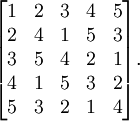Small Latin squares and quasigroups
Below the Latin squares and quasigroups of some small orders (the side length of the square, or the number of elements of the quasigroup) are considered.
Order 1
For order 1 there is 1 Latin square with symbol a and 1 quasigroup with underlying set {a}; it is a group, the trivial group.
Order 2
For order 2 there are 2 Latin squares with symbols a and b:
- a b b a
- b a a b
They differ only by labelling, i.e., by a permutation of a and b. Thus there is only one isotopy class.
Each can be taken as a multiplication table with border row "ab" or "ba" and border column "ab" or "ba". These 8 results are 4 by 4 equal as quasigroups, so there are two quasigroups of order 2. Both are groups, the group Z2 with a = e and that with b = e.
Order 3
For order 3 there are 12 Latin squares with symbols a, b, and c; up to relabelling there are 2:
- a b c a b c
- b c a c a b
- c a b b c a
which differ only by the order of the rows. Thus there is only one isotopy class.
Each of the 12 is a multiplication table with border row "abc" and the same border column (other border rows and columns just give other notations of the same quasigroups). Of these 12, 3 represent a group: the group Z3 with a = e, that with b = e, and that with c = e. Relabelling the 2 non-identity elements does not give another group, it is an automorphism.
Order 4
For order 4 there are 576 Latin squares with symbols a, b, c, and d; up to relabelling (e.g. taking abcd as first row) there are 24. Up to relabelling and row order there are 4 (keep the first row as abcd but consider all 6 permutations of the other 3 rows the same), i.e. there are 4 reduced Latin squares:
- a b c d a b c d a b c d a b c d
- b a d c b a d c b c d a b d a c
- c d a b c d b a c d a b c a d b
- d c b a d c a b d a b c d c b a
Up to relabelling with corresponding permutation of the rows and columns (hence keeping the first row abcd and the first column abcd) the last 3 are the same. Thus there are 2 isotopy classes.
Each of the 576 is the multiplication table of a quasigroup with border row "abcd" and ditto border column, 144 for the first isotopy class and 432 for the second.
To find the loops (i.e., quasigroups with an identity element), assume that a is the identity. Then the first row is equal to the border row and the first column to the border column, so we have the four cases shown above. Without the restriction that a is the identity there are 16 cases:
- 4 in the first isotopy class: 4 versions of the Klein four-group, differing only by the choice of which of the 4 elements is the identity. Permutations of the other three elements do not change the group: they form the automorphism group of the group, i.e., all three play the same role.
- 12 in the second isotopy class: 12 versions of the cyclic group of order 4, differing by the choice of which of the 4 elements is the identity, and which of the other 3 has order 2. Apart from that there is only one, corresponding to the fact that interchanging the remaining two elements generates the automorphism group of this group.
Of the 576 Latin squares, 288 are solutions of the 2×2 version of Sudoku, sometimes called Shi Doku . With first row abcd and first column acbd this reduces to 2.
Order 5
For order 5 there are 161,280 Latin squares with symbols a, b, c, d, and e. There are 280 loops: 5 times the number of reduced Latin squares. 30 of these are groups, all are versions of the cyclic group of order 5. They differ by the choice of which of the 5 elements is the identity, and, for a given non-identity element, the choice which is its square and which its cube. The number 30 is 5! divided by 4, the order of the automorphism group.
An example of a reduced Latin square is:

The element corresponding to the 5th row times the inverse of the element corresponding to the 1st row corresponds to the permutation transforming the 1st row in the 5th, i.e. (154)(23), hence its square is not a bijection, hence this cannot represent a group.